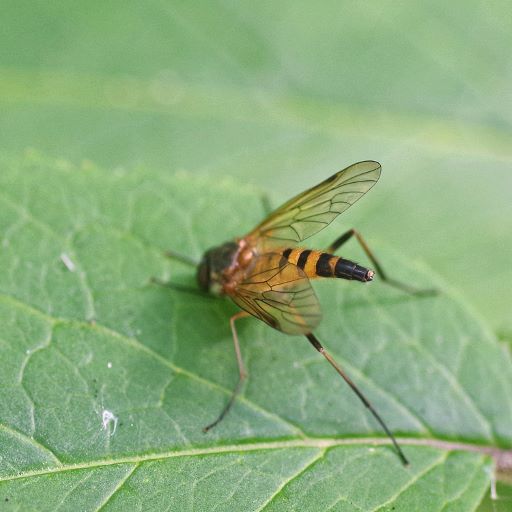
Flies without Bios II
Howdy, BugFans,
The BugLady is always ambivalent about photographing flies, even when they pose nicely. There are a whole heck of a lot of species of Diptera (“two wings”) out there – 17,000 in North America and 150,000 worldwide (some estimates of the eventual total go as high as a million species) – so unless it’s a really dramatic fly, there’s a pretty good chance the picture will end up in the “X-Files.” On the bright side, with that number of species, you can expect quite a bit of diversity – these are not all house fly-shaped-objects: https://bugguide.net/node/view/1126926, https://bugguide.net/node/view/2223038/bgimage, https://bugguide.net/node/view/1476962/bgimage, https://bugguide.net/node/view/2225982/bgimage, https://bugguide.net/node/view/2034795/bgimage, https://bugguide.net/node/view/35812.
Most insects have wings, and most insects that have wings have four of them. The conspicuous, membranous flying wings on these “two-winged” flies are actually the front pair of wings – the hind pair has been modified into knob-shaped structures called halteres https://bugguide.net/node/view/130687, which provide sensory feedback that helps the fly maintain stability in flight. Most flies feed on liquids that they sponge/suck up (in species like horse flies and mosquitoes, the sponging mouthparts are augmented by cutting blades that get the juices flowing). As a group, flies spread both pollen and disease, though the former is more common than the latter.
The “Without Bios” series celebrates insects whose profile is low – insects that are neither big enough nor bad enough nor beautiful enough to have been studied much, if at all.
SNIPE FLIES (family Rhagionidae) are also known as “downlooker flies” because of their habit of perching head-downward. They’re called Snipe flies because someone (in a fit of poetic license) thought that their protruding mouthparts looked like a snipe’s bill https://bugguide.net/node/view/1219348/bgimage. They tend to have long legs, and while most are drab-looking, some are spectacular. They like woods and wetland edges, and they prey on small insects. Bugguide.net tells us that their taxonomy “has been unstable.”
[Brief aside for non-birders. Yes, snipe are a thing. They are long-billed, medium-sized shorebirds https://www.allaboutbirds.org/guide/Wilsons_Snipe/overview that are often seen in the shallow water at the edges of wetlands. The snipe hunt you went on at Camp didn’t have anything to do with actual Snipe.]
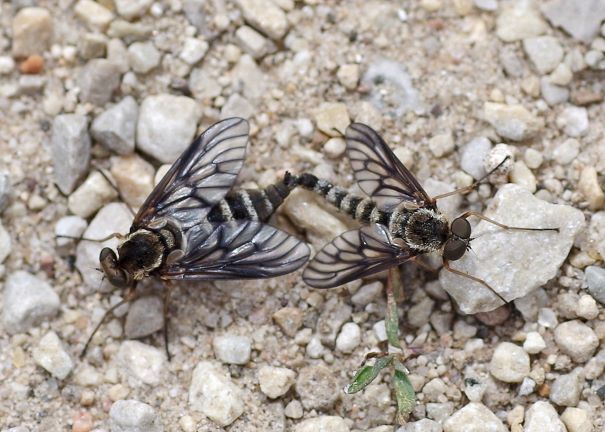
SNIPE FLIES #1 – One of the more spectacular species.The BugLady has poked around at IDing this pair of flies off and on for years. The heavy markings on their wing veins resemble those of the very spiffy Golden-backed Snipe Fly (Chrysopilus thoracicus) https://bugguide.net/node/view/1974388/bgimage, but – no Chrysopilus (“golden hair”). Turns out that they are Chrosopilus foedus (no common name). About them, the BugLady found that the adults perch on vegetation and on dirt roads, the larvae eat small worms, soft-bodied insect larvae, and grasshopper eggs, and like the Golden-backed snipe fly, they have a late spring flight period.
The BugLady is interested in the etymology of entomology, and she discovered that the species name foedus has several unrelated meanings. The first (a noun) is a “treaty, league, tie, bond, or pact;” second (an adjective) is “disgusting, foul, loathsome, ghastly, unclean, obscene, etc.”
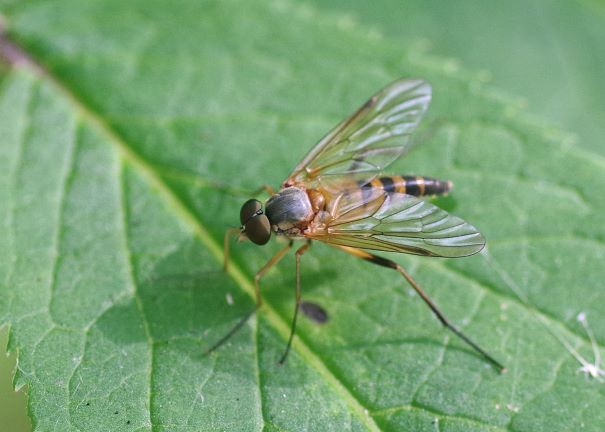
The BugLady encountered SNIPE FLY #2 (Rhagio hirtus) (maybe) along a woodsy edge, and she was fascinated by its behavior. Every once in a while, as it ran around on the leaf, it would lower its head and push it around a bit on the leaf’s surface. No idea. (Well, two ideas – 1) some kind of myopic hunting behavior, or 2) it had been taken over by a brain-eating, zombie-making fungus.)
When she was prowling the dunes at Kohler-Andrae State Park last summer, the BugLady saw BEE FLIES, aka Humbleflies, (family Bombyliidae) of at least three species. There are lots of Bee flies globally, but the lives of many of them are poorly known. Adults are generally nectar feeders (they sip nectar through a non-retractable proboscis), and many are bee-mimics (and they make the requisite buzzing sound). Larvae are parasitoids of ground-nesting insects like beetles, moths, and solitary bees and wasps.
Mom locates a nest tunnel and lobs an egg into it while its creator is away looking for provisions for her eventual larvae (actually, Mom will throw an egg into any shadowy area that looks tunnel-ish, but she can afford to waste, because she can lay hundreds of eggs each day). In order to add a little weight to the egg as she releases it, Mom picks up some sand, which she stores in a chamber (OK – a “psammophore“) at the tip of her abdomen. Some sand adheres to the egg as it passes by, making it heavier and camouflaging it. It’s theorized that since bee flies are soft-bodied, this method of laying eggs prevents them from close encounters with the owner of the tunnel, who may be upset by the intrusion and is packing a stinger.
The larvae are unusual in being very active in their first larval stage (hypermetamorphosis) – this lets them scurry down the tunnel and search for a host. They let themselves into an egg chamber, and then settle down to normal larval speed, and eat the stored pollen and then the rightful owner of the cell. The bee fly emerges the following spring in sync with the flight period of its target host.
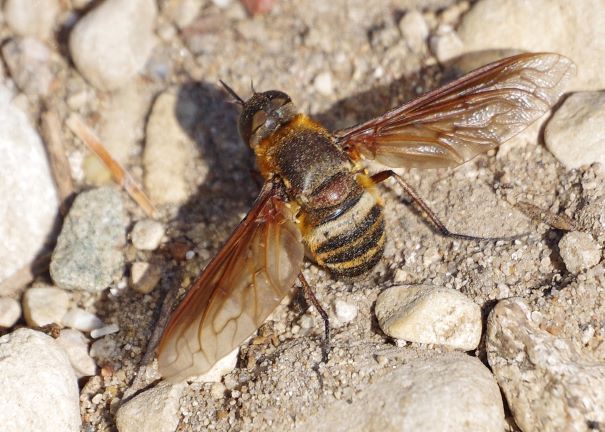
Bee Fly #1 – Exoprosopa fasciiata (probably), aka the Barred Bee fly, is pretty common east of the Great Plains. “Fasci” means “band” and refers to the white band on the abdomen.
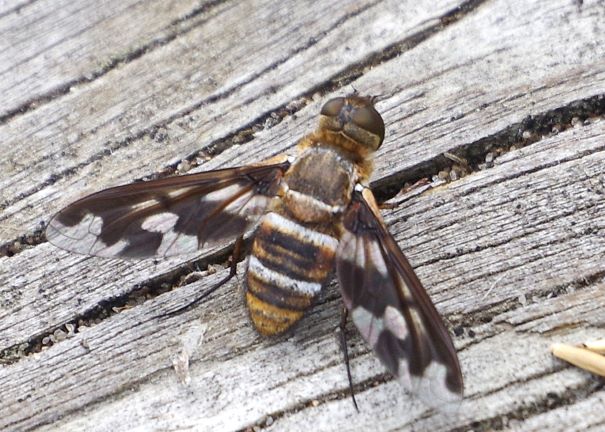
Bee Fly #2 – Exoprosopa fascipennis (no common name). “Fasci” means “band,” and “pennis” means “wing.” It’s found throughout the summer at beaches and sandy meadows over the eastern half of the continent. It looks for the tunnels of Tiphiid wasps and sand wasps.
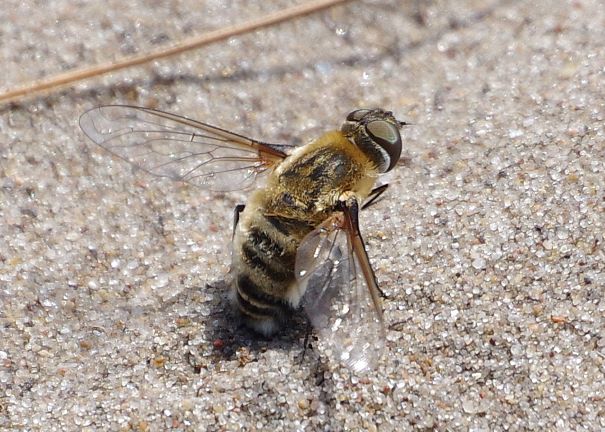
Bee Fly #3 – Villa lateralis (probably) (bugguide says that because their markings are variable, “identification to species is tentative at best”). Larvae of flies in the genus Villa feed on (in) the larvae of stag beetles, moths, horse flies, and ant lions that they find under the sand.
Available for all three bee fly species are extensive descriptions of every part of their anatomy, but not biographies.
The BugLady confesses (no surprise) that she’s always had a soft spot for predators, and ROBBER FLIES (family Asilidae) are amazing poster children for unapologetic meat-eaters. There are lots of them – 7,500 robber fly species worldwide, 1,040 in North America, and about 100 in the Great Lakes area. Robber flies have eyes worthy of a predator and long legs that the BugLady thinks look double-jointed somehow https://bugguide.net/node/view/1292828/bgimage). They usually sport a beard (“mystax”- which is both Greek and Latin for “moustache”) https://bugguide.net/node/view/1692598/bgimage. They like the sun, and they often perch on vegetation at woodland edges so they can scan for prey (the BugLady once saw one shoot straight up off a leaf in pursuit of a butterfly overhead). They’ll go after bugs that are bigger than they are, including other robber flies, and one theory about the mystax is that it protects their faces from the stinging insects they catch. Their larvae live in soil and rotting wood and eat small invertebrates that they find there.
What happens when a robber fly’s hunt is successful? Jeff Milton, in the Colorado Arts and Sciences Magazine, says it well: “Robber’s modified mouthparts form a stiff, hollow beak that serves first as a dagger, then as a hypodermic needle and finally as a straw. When robbers impale prey they inject both neurotoxins and digestive enzymes. The neurotoxins quickly subdue and soon kill the prey. The digestive enzymes turn the prey’s internal tissues to soup, but do not damage the tough chitinous exoskeleton, which now serves as a watertight container full of thick broth. Fluids are sucked through the beak until the carcass until is a dry husk.”
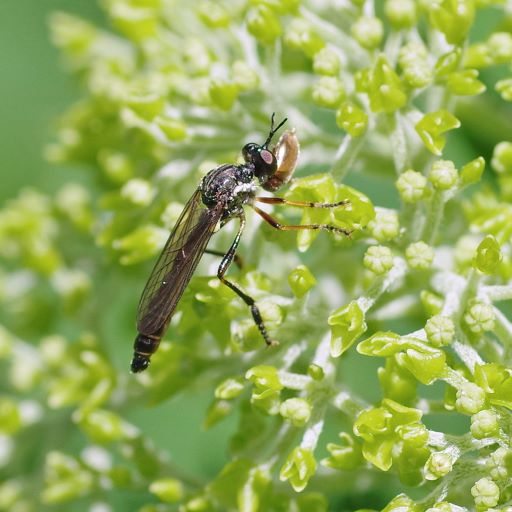
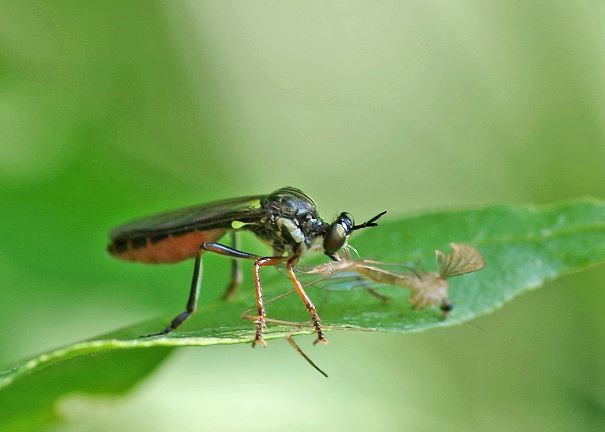
The STRIPE-LEGGED ROBBER FLY (Dioctria hyalipennis) (hyalipennis means “glassy wing”) is one of the more petite robber flies, and it’s easy to overlook. It favors smaller prey like files, small wasps, sweat bees, and pygmy grasshoppers.
According to Mike Reese in his awesome Wisconsin Butterflies website https://wisconsinbutterflies.org/ (which includes tiger beetles and robber flies), the SLRF is one of two non-native robber flies in North America. It was first recorded in Boston in 1916 and was given a new name in its new country until scientists realized that it already had one in Europe. It’s found across the northeastern quadrant of this continent and, inexplicably, in Oregon, and across Europe into North Africa. The BugLady found articles about it in Finnish, Dutch, French, and Polish.
Nota bene: when you’re writing the common name of a dipteran, the word “fly” is always separate – house fly, deer fly, etc. When you write the name of a non-dipteran whose name includes “fly,” fly is incorporated – mayfly, dragonfly, firefly.
Flies are some of the earliest insects to venture out onto the landscape in spring (especially the very cold-tolerant Chironomid midges). Get ready!
Kate Redmond, The BugLady
Bug of the Week archives:
http://uwm.edu/field-station/category/bug-of-the-week/
